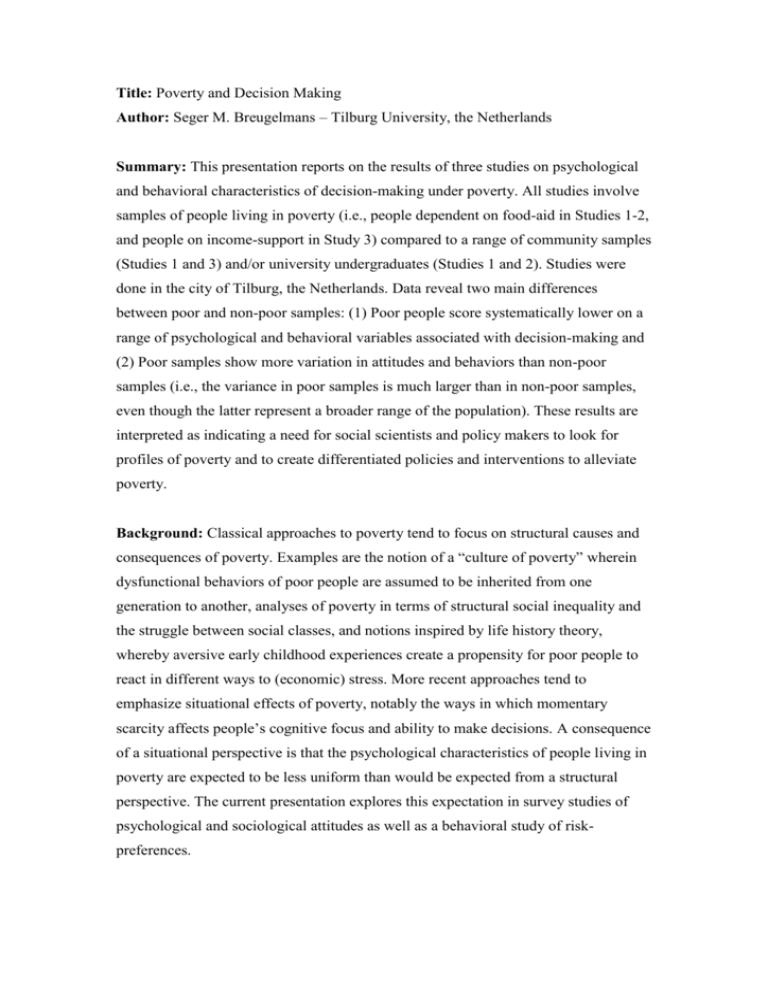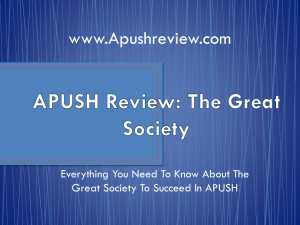Title: Poverty and Decision Making Author: Seger M. Breugelmans
advertisement

Title: Poverty and Decision Making Author: Seger M. Breugelmans – Tilburg University, the Netherlands Summary: This presentation reports on the results of three studies on psychological and behavioral characteristics of decision-making under poverty. All studies involve samples of people living in poverty (i.e., people dependent on food-aid in Studies 1-2, and people on income-support in Study 3) compared to a range of community samples (Studies 1 and 3) and/or university undergraduates (Studies 1 and 2). Studies were done in the city of Tilburg, the Netherlands. Data reveal two main differences between poor and non-poor samples: (1) Poor people score systematically lower on a range of psychological and behavioral variables associated with decision-making and (2) Poor samples show more variation in attitudes and behaviors than non-poor samples (i.e., the variance in poor samples is much larger than in non-poor samples, even though the latter represent a broader range of the population). These results are interpreted as indicating a need for social scientists and policy makers to look for profiles of poverty and to create differentiated policies and interventions to alleviate poverty. Background: Classical approaches to poverty tend to focus on structural causes and consequences of poverty. Examples are the notion of a “culture of poverty” wherein dysfunctional behaviors of poor people are assumed to be inherited from one generation to another, analyses of poverty in terms of structural social inequality and the struggle between social classes, and notions inspired by life history theory, whereby aversive early childhood experiences create a propensity for poor people to react in different ways to (economic) stress. More recent approaches tend to emphasize situational effects of poverty, notably the ways in which momentary scarcity affects people’s cognitive focus and ability to make decisions. A consequence of a situational perspective is that the psychological characteristics of people living in poverty are expected to be less uniform than would be expected from a structural perspective. The current presentation explores this expectation in survey studies of psychological and sociological attitudes as well as a behavioral study of riskpreferences. Studies: Study 1 was an exploratory study on the psychological characteristics of people dependent on food-aid. Data were drawn from two sources: social welfare files and a survey. The social welfare files were used to examine the background profiles of the food-aid sample; the survey was used to compare the psychological profile of food-aid participants (N=76) with that of several community samples from the same city: a sample of unemployed who participated in a re-integration program (N=49), undergraduate students from Tilburg University (N=111), and a sample of middleclass participants from the city of Tilburg (N=142). Cluster analysis on the coded background characteristics from the social welfare files revealed two main categories: people whose problems were primarily financial in nature and people whose problems were primarily socio-emotional in nature. ANOVAs on the survey scales showed that in comparison to all other groups, people on food-aid experienced lower self-control, lower trust and social capital, and more mental depletion. Study 2 built upon these findings, comparing a broad range of established psychological and sociological constructs related to decision-making between a sample of people on income-support (N=229) and a community sample of Tilburg citizens (N=328). Participants completed 13 scales on satisfaction with finances and life, self-regulation, trust and social capital. MANOVA revealed significant differences between groups, Wilks’ Lambda=.64, F(13, 410)=17.53, p<.001,η2=.36. Subsequent univariate analyses revealed significant differences on all scales except self-control. Participants on income-support were on average less satisfied with life (including health and fincances) finances in life, experienced more problems with self-regulation (except self-control), experienced lower trust and lower social capital. Importantly, the variation in responses among the income-support group was markedly larger than among the community sample. Tests of homogeneity of variance showed significant differences for 9 scales; in 8 out of 9 cases the variance was significantly larger in the income-support group. Study 3 focused on behavioral measures, examining the risk-preferences in a independent sample of food-aid (N=98) clients compared to a group of undergraduate students from Tilburg University (N=64). Participants were presented with a set of choices between a gamble and a certain outcome. For gains, participants chose between a gamble which offered a 50% probability of gaining €20,- and a 50% probability of gaining €0,- (the gamble was visually represented by a six-sided die with three red sides and three green sides, which could be rolled once; green meant winning €20,- and read meant winning nothing) and a certain sum. Using a funneled procedure, participants indicated for each certain sum between €1,- and €19,- whether they preferred the gamble or the certain sum. The same procedure was done for losses, with the differences that losses were half the size of the gains (i.e., a 50-50 gamble between -€10,- and -€0,- or a certain loss ranging from -€0,50 to €-9,50). After all choices had been made, participants had the opportunity to review their choices and make any changes if so preferred. When the choices were final, one choice in gains and one choice in losses was randomly selected (using a 20-sided die rolled by the participant) and paid out, with any gains integrated with any losses. In addition, there was a fixed participation fee of €5,- which was always paid out, independent of the outcome of the decisions, so that participants would always leave the experiment with a positive sum of money. Decisions for gains and losses were analyzed in terms of the number of gambles that people chose (ranging from 0 to 19). Values lower than 9 indicate risk-aversion, values of 9 or 10 indicate risk-neutrality, and values higher than 10 indicate risk-seeking. ANOVA on gains and losses revealed no significant differences between students (Mgains= 8.64, Mlosses=10.34) and participants on food aid (Mgains= 7.95, Mlosses=9.53) in average risk-preference. However, there were marked differences in the variance of risk-preference between both groups; students showed much less variation (SDgains= 2.82, SDlosses=2.10) than food-aid participants (SDgains= 4.85, SDlosses=5.57).








